|
Milanese
Master Luthier Luigi Galimberti
by Gregg Miner
January, 2018
Introduction
I continue to find it
fascinating that although Italy is just 3% the size of the United
States, their harp guitar designs are at least as plentiful and diverse
as those created in America. Some
even surpass our Knutsens and Gibsons in creativity.
They also began experimenting with them long before American’s
got wind of them, and kept up some of their harp guitar traditions long
after American’s got tired of the “fad.”
Throughout the early 1900s,
several dramatic styles and regional Italian “schools” developed.
This site has long highlighted those in Genoa (Gazzo and Candi),
along with the output of Mozzani and Maccaferri and their followers. I’ve
also been fascinated with – and have tried to archive – the many
builders involved with the Monzino firm in Milan.
The subject of this piece is one of those.
 I became aware of Milan’s Monzino & Sons (they later morphed into
Monzino & Garlandi) after acquiring a wonderful harp mandolin of
theirs back in 1989 (at left). Over
the years I learned that some of the more spectacular instruments were
built by others – names unfamiliar to me. From about 1906 onwards,
the Monzino firm contracted some of the area's best luthiers,
while also providing training, thereby creating an authentic school.
Building guitars and harp-guitars, mandolins and bowed
instruments, the first wave included the Antoniazzi brothers,
Ermino Farina, Severino Riva and Innocente Rottola. The
next generation of Monzino’s luthiers included Ambrogio Sironi,
Piero Parravicini, and Luigi Galimberti, the subject of this
article.
Some
years ago, the Monzino Foundation established a web site where they
presented some of the firm’s history and instruments.
My overview of that site and my own Monzino harp guitar page resides
here. I became aware of Milan’s Monzino & Sons (they later morphed into
Monzino & Garlandi) after acquiring a wonderful harp mandolin of
theirs back in 1989 (at left). Over
the years I learned that some of the more spectacular instruments were
built by others – names unfamiliar to me. From about 1906 onwards,
the Monzino firm contracted some of the area's best luthiers,
while also providing training, thereby creating an authentic school.
Building guitars and harp-guitars, mandolins and bowed
instruments, the first wave included the Antoniazzi brothers,
Ermino Farina, Severino Riva and Innocente Rottola. The
next generation of Monzino’s luthiers included Ambrogio Sironi,
Piero Parravicini, and Luigi Galimberti, the subject of this
article.
Some
years ago, the Monzino Foundation established a web site where they
presented some of the firm’s history and instruments.
My overview of that site and my own Monzino harp guitar page resides
here.
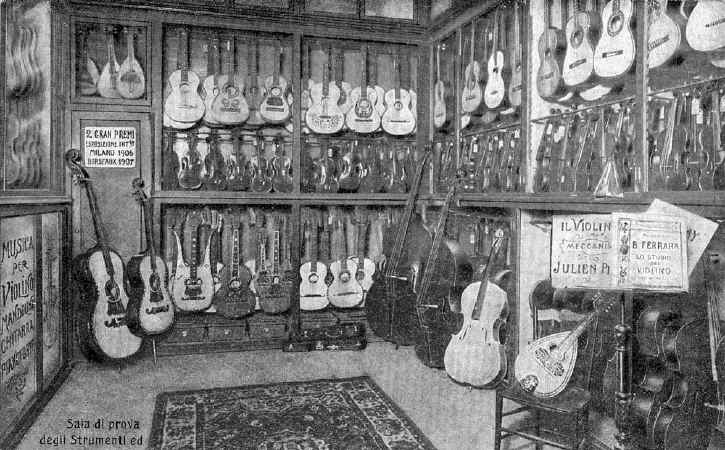
The
shop of Antonio IV Monzino & Sons, Milan, 1914. Several harp guitars
can barely be seen behind and to the right of the lyre-shaped guitar.
Galimberti
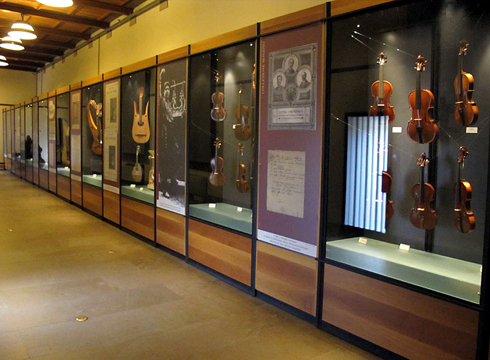 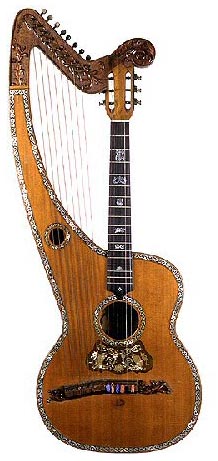 After
ogling the instruments on the Monzino Foundation site, the 1910 Galimberti harp
guitar (at left) was one I hoped to see when I was fortunate enough to
visit the Monzino
collection in Milan’s Sforzesco Castle
Museum in 2012. After
ogling the instruments on the Monzino Foundation site, the 1910 Galimberti harp
guitar (at left) was one I hoped to see when I was fortunate enough to
visit the Monzino
collection in Milan’s Sforzesco Castle
Museum in 2012.
The instruments were exquisite
and enthralling, though Galimberti’s harp guitar was not on
exhibit, nor were his two elaborately carved harp mandolins from 1924
and 1930.
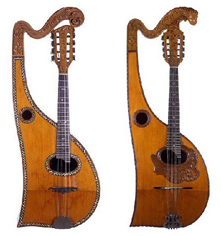
Only one other surviving harp
guitar known to have been built by Luigi Galimberti has so far been
discovered, and I was lucky enough to acquire it in 2017:
|
Galimberti 1932
Harp Guitar
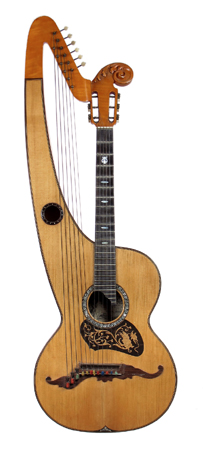 |
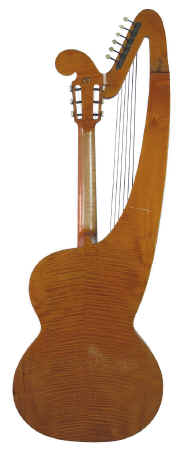 |
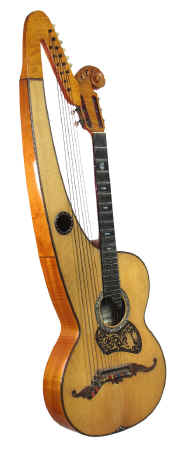 |
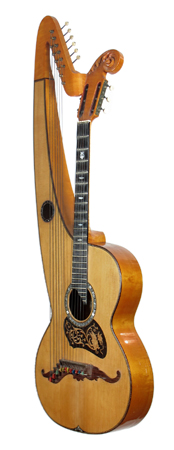 |
|
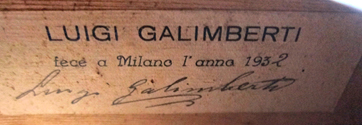 This
has the standard Monzino & Garlandini label of this period
visible through the main soundhole, and this second
hand-signed label visible through the arm soundhole.
It
is in all
original condition, as received (unrestored). The scale length
is 25-5/8" and the body is a delicate 15-1/2" wide
by 3-1/2" deep. The total length is a dramatic
46", which the sub-bass strings take advantage, ranging
from 30-1/2" to 36-1/4" in vibrating length.
It has beautiful flame maple back
and sides, with some noticeable belt buckle wear and other
signs of love. This
has the standard Monzino & Garlandini label of this period
visible through the main soundhole, and this second
hand-signed label visible through the arm soundhole.
It
is in all
original condition, as received (unrestored). The scale length
is 25-5/8" and the body is a delicate 15-1/2" wide
by 3-1/2" deep. The total length is a dramatic
46", which the sub-bass strings take advantage, ranging
from 30-1/2" to 36-1/4" in vibrating length.
It has beautiful flame maple back
and sides, with some noticeable belt buckle wear and other
signs of love.
|
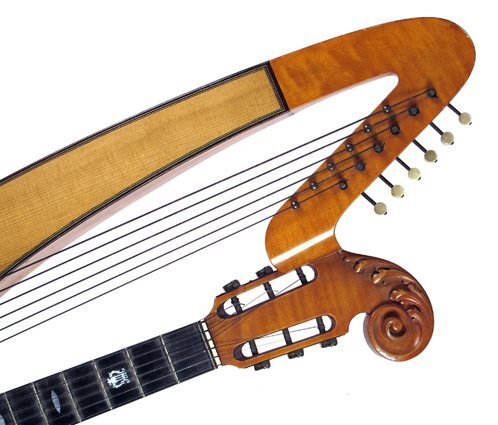 |
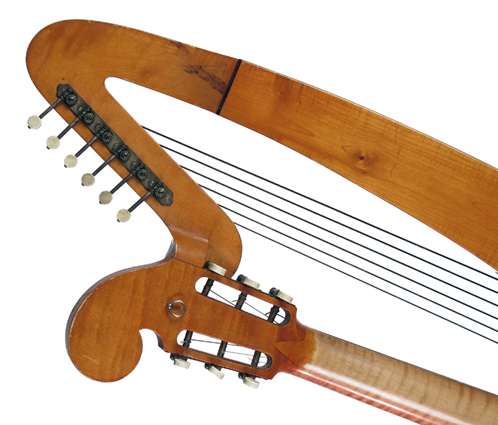 |
|
As seen in my Monzino
gallery, many of the firm's luthiers followed the template
of the hyper-extended hollow arm and tight twist to accommodate
the 6 or 8 sub-bass tuners. Note the possibly original
ring for hanging on the wall when not in use.
 |
 |
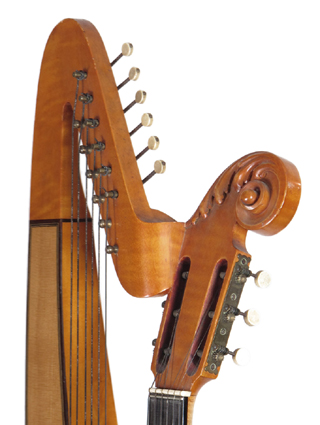 |
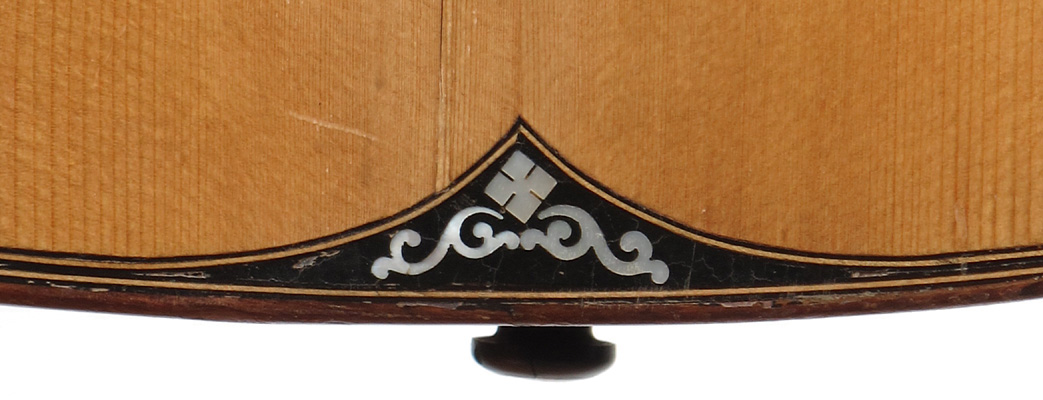 |
| I love this bridge shape, especially the
"stair-step" for the lowest bass
strings. The only real damage that needs attention is a
crack in the bridge. I'll address it someday...though
unusable, I love the original silk & steel strings with
the fuzzy color silk wraps. Yes, despite the very sparse
ladder bracing, this was strung in silk & steel, and may have
been even when new. Most "popular music" harp
guitarists of Italy preferred the brighter, louder sound of
steel, especially as they so often backed up mandolin
ensembles. Note the "zero-nut," a feature on
virtually every old or new Italian guitar I've seen. The
creature in the wood marquetry pickguard is a nice touch, as
is the soundboard's tail embellishment. Geared tuners
all the way make this a practical working instrument. |
|
|
|
|
Galimberti Family Treasures
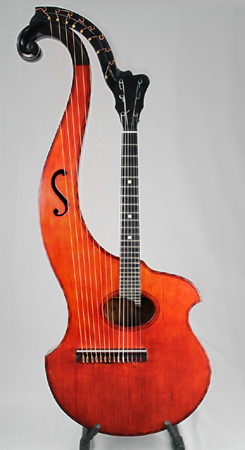 |
Towards the end of 2017 I was
contacted by the extended family of Luigi Galimberti's grandson , who live in the
same small town of Seveso where Galimberti lived and worked.
They were asking about this incredible, just-restored harp guitar
in their possession. Acquired
by Luigi’s luthier son Lodovico around 1960, it’s actually an
unrelated, unlabeled instrument (our guess is Genoese). Restoration by
Domenico Bertoletti can be seen here. What a unique and
beautiful instrument!
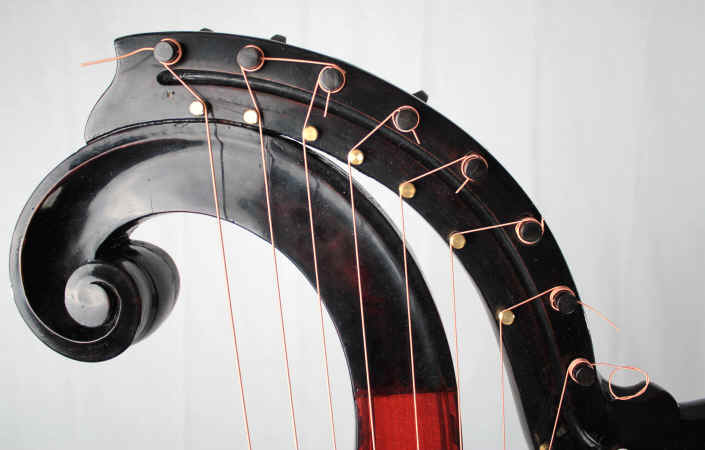
|
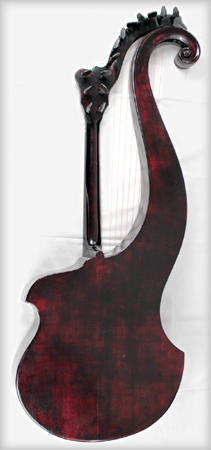 |
The family does have a few
original Luigi Galimberti instruments, along with photos from his
career, which they’ve graciously shared with us here.
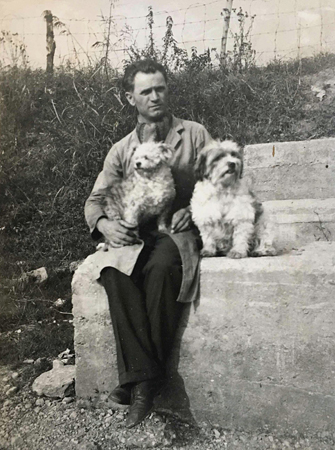 |
These
handsome photographs of Luigi Galimberti were taken before
World War II.
|
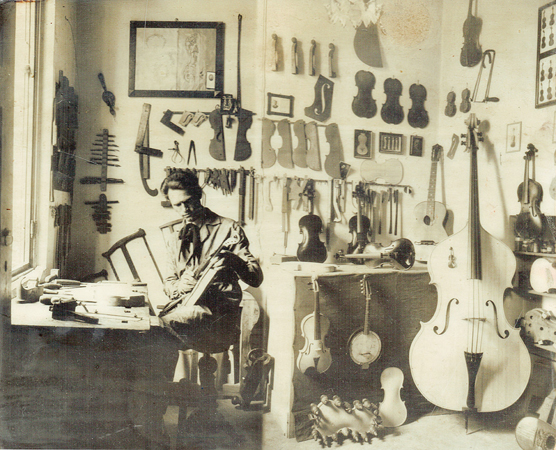 |
|

Luigi's son
Lodovico followed him into lutherie.
|

Galimberti
garnered dedications from a plethora of players throughout
his life, including names like
Zuccheri,
di Ceglie, Servida, Balzaretti, Policenti, Tolotti,
Chiodi, and Vancheri.
Presumably, some of these guitarists are playing Galimberti
instruments.
|
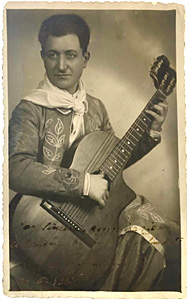
This 1933 photo
and dedication is from Federico Galimberti, no relation to
Luigi. Harp guitarist F. Galimberti appears elsewhere
on this site with Mozzani and Maccaferri hollow arm harp
guitars; I can’t positively I.D. this one.
|

As demonstrated by the
signed photographs above, unless they were strictly “classical
guitarists,” professional and amateur Italian players would
switch to semi-acoustic archtop guitars and electrified versions
of same. Most builders quickly responded and adapted to the
new forms and tastes, just as American firms did from the 1930s
on. These are photographs of four different Luigi Galimberti
archtop acoustic and semi-acoustic electric guitars.
|
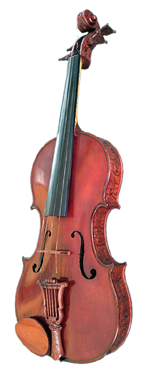
The Galimberti
family owns several original instruments by Luigi from
different eras, including this spectacularly carved
violin.
|
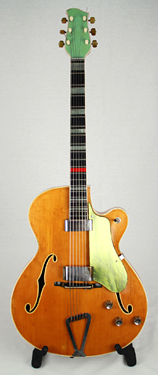
A nice flame
maple archtop with progressive colored accents
|
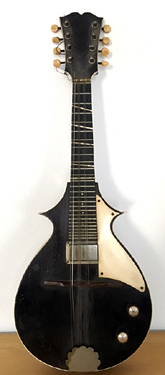
A striking
solidbody electric mandolin
|

Luigi's son Lodovico’s
built this classical guitar
for his son (also named Luigi), who never picked it up.
Today, his daughter is instead learning on it.
|
|

|
|

|
|
|
The
standout for me was this photograph of an unknown guitarist
(signature illegible) playing a wonderfully designed harp
guitar. It could
have easily been built by Galimberti, but we have no way to
know. Here it is
compared with mine. Despite
the very similar bridge, it could have been made by any
number of the other Monzino luthiers.
Taking
all this in, I’m envisioning the Monzinos (Antonio's IV, V
& VI during this time) with their stable of luthiers in a very creative
environment, continually trying to surprise and top one
another with instruments like these.
What fun their customers must have had!
|
Luigi
Galimberti Biography
Asking for biographical
information on their luthier ancestor, the family provided the following information (edited
by GM):
Luigi Galimberti
was born on October 29th, 1888 in Seveso, a small village
near Milan.
Woodworking – carving, inlaying and furniture making – was
widespread in the town, so he naturally turned to this profession.
After a period of lutherie specialization in Paris he started
working with Romeo Antoniazzi in 1915, following the instrument models
of the Cremonese school.
Luigi worked at the Monzino and
Garlandini workshop from January 1st, 1928 to July 19th,
1930, after which he opened his own shop, first in Piazza Borromeo 7,
then in Via Dolomiti 17. In
addition to Monzino, he also supplied musical instruments for the "Messaggerie
Musicali" store and for famous artists of those years.
He won prizes and medals in Rome
and Florence and showed four violins and a viola at the historic 1937
International Exhibition held in Cremona. He was a prolific maker of
bowed instruments, including 30 double basses and many guitars. His
instruments are highly regarded for the buff polished, golden-yellow
varnish, both oil and spirit based.
Occasionally, guitars labeled "Galimberti L."
are seen that were produced after
1957, the year of his death – but they were built by his son Lodovico
Galimberti, who helped his father in the construction of guitars in
Seveso.
Some of Luigi
Galimberti’s instruments are exhibited in museums: the "Museo del
violino" (Sala Stradivari) in Cremona, the "Museo degli
Strumenti Musicali" Collezione Monzino in Castello Sforzesco,
Milan, and now the Miner Museum in Southern California!
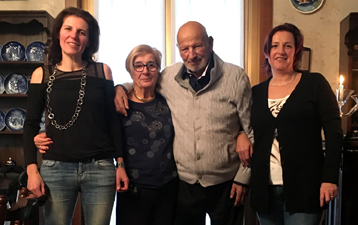 A
special thanks to the extended Galimberti family A
special thanks to the extended Galimberti family
Pictured:
Luigi
(grandson of the luthier Luigi, son of Lodovico), his
wife Giovanna, and their daughters Laura (right) and Federica
(left). Federica's husband is Andrea Tagliabue, who kindly provided
the biography above and handled correspondence for this article.
Additional Sources: Fondazione
De Musica, Civico Museo Degli Strumenti Musicali 2/1/2017:
New Galimberti
Wikipedia page |
